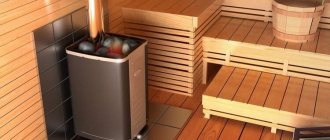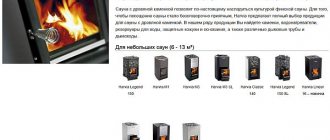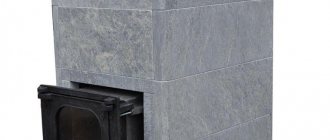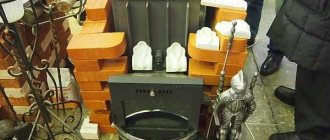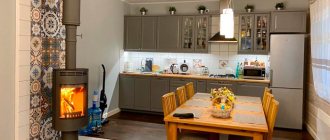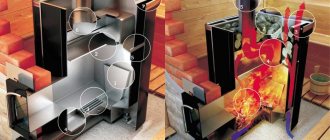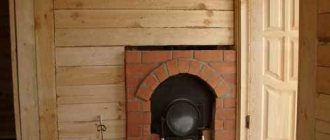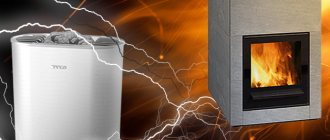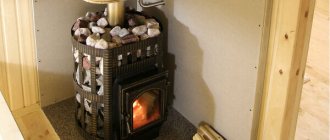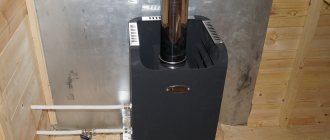Modern technologies have significantly expanded the capabilities of bathing lovers, thanks to the development of unique prefabricated ATB cast iron stoves designed for baths and saunas. Such furnaces were the first in Russia to be produced in 1985 by the PetrozavodskMash-TNP enterprise, which has already mastered a whole line of such products under the Karelia brand. Their design options are different: with or without a water tank, with a firebox inside or outside the steam room, with a closed or open heater, with tanks of various volumes, models with different capacities.
About the manufacturer:
It is called "PetrozavodskMash - TNP". He has been making iron casting for fifty years, and he began casting furnaces thirty years ago. I’m talking about this because cast iron, as a material for a bathhouse, is excellent. However, without experience and professionalism, the result is something awkwardly short-lived. By the way, the abbreviation “ATB” is an old name, but many people remember it and remember it only with positive emotions. The plant is located in the Republic of Karelia. Hence the name of their products...
Why cast iron is the most suitable material for sauna stoves
Because it provides:
Comfortable warmth
The comfort indicator is determined by the wavelength of the spectrum of electromagnetic radiation. The longer it is, the more pleasant the emanating heat is for a person. I’ll say it differently: for example, a steel stove heated to the same temperature will create more “harsh” thermal radiation, which is less beneficial to the body. Even simpler: a cast iron stove “burns” less oxygen in the steam room. Therefore, some manufacturers of steel products are trying to equip their furnaces with so-called screens that reduce acute heat.
Durability of use
This is a particularly strong point in relation to steel and brick stoves. Cast iron has higher corrosion resistance than carbon steel. Therefore, he has more time to burn out. According to experts, the service life of a cast iron stove is approximately 1.5-2 times longer than a steel one. In addition, cast iron is much less susceptible to expansion caused by high temperatures. Accordingly, there is less deformation during the process. In other words, “the parts keep their factory shape.”
Speaking about brick “brothers”, their durability is within 7 years, since any brick crumbles and cracks over time. Somewhere earlier, somewhere later. And to restore brickwork, a specialist is required.
For information: the passport of the Karelia ATB furnace states: the minimum service life, subject to operation of 170 hours per year (that is, ≈ 3-3.5 hours per week), will be 15 years. By the way, many stoves produced by the plant in the late 80s still heat well. And the factory warranty for a cast iron Petrozavodsk stove is 30 months (in contrast to factory steel ones, which are guaranteed for 12 months).
Unfortunately, there is no 100% protection against ignorance. This is why stove manufacturers curse when they are told about problems that arose during the warranty. Many of these problems are caused by the buyer's failure to comply with basic operating rules.
Regarding such an indicator as the rate of heat accumulation, I will inform you: a cast-iron stove is slightly inferior in heating time to a steel stove, but superior to a brick one. If we talk about cooling, the opposite is true: steel takes longer to cool, but faster than brick. I think you know this yourself.
There are other advantages, however, I do not consider them significant.
The main consumer features of the Karelia stove for a bath
Again, I won’t list too many, but I’ll name three (in my opinion) main ones:
Easy assembly
All ATB cast iron stoves are completely ready for use after assembly. When installing, they do not require special knowledge or special tools. The parts are installed sequentially according to the instructions. For convenience, the components are packaged separately in wooden containers. This makes their delivery and unloading easier. If necessary, you can buy the required part and replace it. It won't be difficult. By the way, partial modernization of the furnace is possible in the same way. I removed one part and installed another. And I received an updated stove with improved characteristics or other functionality.
And the “heart of the heater” - the combustion chamber, is made in the form of a monolithic element. He's the heaviest. In large models, the weight reaches 40 kg. Cast iron, however...
Karelia 2 Karelia 5
All models provide a technically convenient option for cleaning the channels from furnace soot. To do this, it is enough to remove one part. Disconnecting the chimney is not required.
Functional design
The body is made of castings made from gray heat-resistant cast iron. Their total number is within 11 pieces. All models have a cylindrical round shape. This is important during thermal exposure, allowing a significant reduction in linear and volumetric expansion. The developed ribbed surface of the external elements makes it possible to further increase heat transfer, up to 30%. The result is faster heating of the room and less wood consumption.
The design of the chimney has an innovative feature. The exhaust flue gases go through a multi-circuit path, partially transferring high-temperature heat back to the structural elements. Such a rational solution, again, saves fuel.
High efficiency
This is an important indicator: higher efficiency means less fuel. In models with a closed heater, it reaches 75%, and for open ones, 60%. Such results are ensured by innovative design features of the furnaces and confirmed by tests of accredited certification bodies. For cast iron, this is generally excellent. Believe me, I know what I'm talking about.
I’ll also add that in all models the “idle” convection process is significantly reduced. The heated air does not immediately float up, but moves through the annular gap between the stove and the tank (or casing). The temperature on the handles and walls of the oven is within standard limits.
Well, that's probably enough information. I won't bore you with unnecessary detail. Let me move on to the third question.
WHITE OR “IN WHITE”
Steam room without soot, clean. Because the smoke goes up the chimney. Actually, all purchased stoves, unless they are electric, are equipped with chimneys. But brick ones can be not only white, but also gray. In the latter case, we are talking about the fact that when water is first supplied to the flow-through heater of a periodic stove, a certain amount of soot may escape into the open door. But it is enough not to completely close the chimney at the first supply and the soot (along with the first steam, however) will be pulled upward. Then you can close the damper completely (after making sure that the wood is completely burned or turning off the gas).
Description of some popular models
Remote tank
The power of ATB sauna stoves ranges from 20 to 40 kW, which will be optimal for most steam rooms. Models are available with a tank for heating water, and specifically with a built-in and remote one. There are sauna stoves for Russian baths and Finnish saunas.
The stove stones heat up to 350° in an open structure and up to 600° in a closed one. Such a high temperature contributes to the appearance of fine (“light”) steam. According to bathhouse experts, it is more pleasant, healthy and easily tolerated by the body. All models, wood-burning. Let's start in ascending order of price. So, Karelia 5
This budget line includes several models. Let's take a closer look.
Karelia 5 classic (open heater) - 20 kW thermal power
The most budget option: with an open heater.
Here, the firebox, chimney, casing, ash pan and some other parts are made from high-quality cast iron. For convenient placement of the stone, the model is equipped with a stainless steel casing, which can have different sizes. The chimney has a diameter of 130 mm. Weight without stones: 172 kg. The total mass of the stones used is up to 50 kg, and their heating temperature is up to 350°.
Firewood for the firebox, no more than 30 cm long. Karelia 5 classic, creates a sauna mode with dry steam, where the air temperature can rise to 110-120 degrees.
Recommended for steam rooms with a volume from 8 to 20 m³, with a washing compartment supplied with hot water.
Karelia 5 with an external portal (open heater) - 20 kW
The unique feature of the model is the elongated combustion chamber with heat-resistant glass. This design allows you to heat the heater from the dressing room or rest room. Transparent glass makes it possible to observe the flames and smoldering embers. In other performance indicators, this model does not differ from the previous one. It also does not come with a water heating tank.
Suitable for saunas with a volume of 8 to 20 m³, equipped with hot water supply.
Karelia 5 with portal (open heater) – 40 kW
This cast iron stove, with a power of 40 kW, has a stainless casing and a remote combustion portal with thick heat-resistant glass. Its dimensions are slightly larger than the “twenty”, and its weight without stones reaches 217 kg. You can lay up to 100 kg of stone on it and heat it up to 350 degrees. The chimney is already 150 mm. There is no water tank provided.
The reinforced (up to 20 mm thick) firebox has two grates, and its elongated shape makes it possible to lay firewood up to 55 centimeters without entering the steam room. That is, it can also be taken out to the adjacent bathhouse.
Typically used for Finnish saunas with a volume of up to 30 m³, which are equipped with a sink with hot water supply.
Karelia 5 with portal (closed heater) – 40 kW
This model differs from the previous one by the presence of a closed heater. The remaining parameters are the same, with the exception of the external dimensions and weight of the furnace (247 kg) and the heating temperature of the stones (up to 600°C). This temperature difference is ensured by the design of the furnace, which “drives” waste high-temperature gases through the stones. When water is supplied to them, the steam room is filled with finely dispersed steam. And the transparent glass allows you to see the “dance of lights.”
I will add that due to its high efficiency, this model requires less firewood than an open heater. But the price of such a stove will be more expensive.
The next model is Karelia 2. There are only three varieties. Let's look at two of them.
Karelia 2 Classic (open heater) – 20 kW
This cast iron stove is equipped with a tank for heating water (60 l) and a non-remote firebox. The chimney diameter is 130 mm, the length of the laid logs is no more than 30 cm. It has a mass of 172 kg, the permissible weight of the stone is 50 kg.
The main feature of the Karelia 2 models is the presence of a water tank made of stainless steel, which also serves as a casing for stones.
It is installed in a Russian bathhouse with a volume of 8 to 20 m³, where the steam room is combined with a washing room.
Karelia 2 with portal (open heater) – 20 kW
The main technical parameters for performance are the same as those of the previous model, however, the presence of an extended fuel channel allows it to be moved outside the steam room. Heat-resistant glass makes it possible to observe what most people love (watching the fire, of course), and a spacious ash drawer makes it easy to remove the remains of coals and ash.
Recommended for use in a Russian bathhouse up to 20 m³, with the possibility of operation from other bathhouses.
And another model is Karelia 4. It provides several varieties. Let's look at two.
Karelia 4 classic (open heater) – 20 kW
Creates “dry” steam for a Finnish sauna. The stove with a water tank is structurally composed of a built-in heater (a rectangular tank of 60 liters), a stainless steel casing and a non-remote firebox. The chimney size is 130 mm, weight is 186 kg, the permissible weight of stones is up to 50 kilograms. Firewood, up to 30 centimeters.
A special feature of the model is that the remote water tank is located in another room. There is a coil in the firebox, which is connected to the tank through pipes. It is hidden inside the structure. The water heating time is approximately two hours.
Designed for use in dry saunas with a wash compartment that does not have hot water.
NET-SEATER
Sometimes stoves are a simplified design without a casing - it is a bare firebox placed in a mesh of metal strips or grates. The space between the firebox and the mesh is intended to be filled with stones. It is they who act as the casing and heater, because water is supplied to them. Moreover, the casing has very strong convection due to the gaps between the stones. Such stoves heat up the steam room very quickly, which has made mesh heaters very popular (not to mention the fact that they also look beautiful). But we will disappoint lovers of the Russian steam room; this option is preferable for a sauna.
